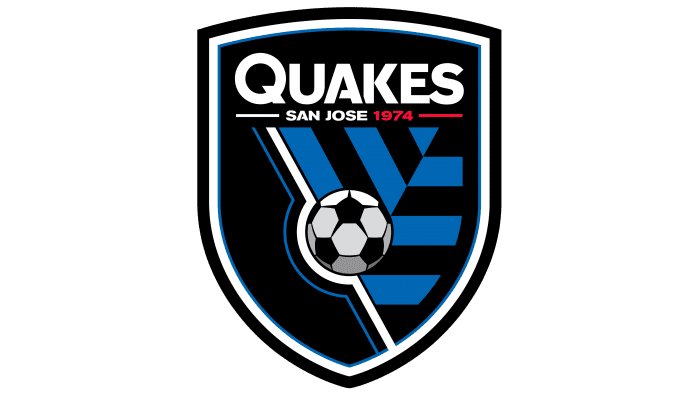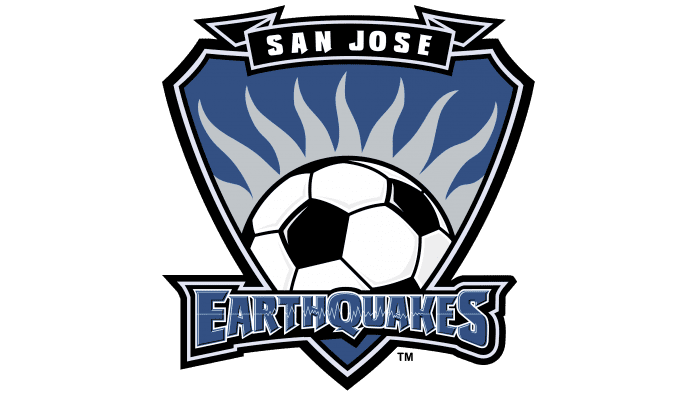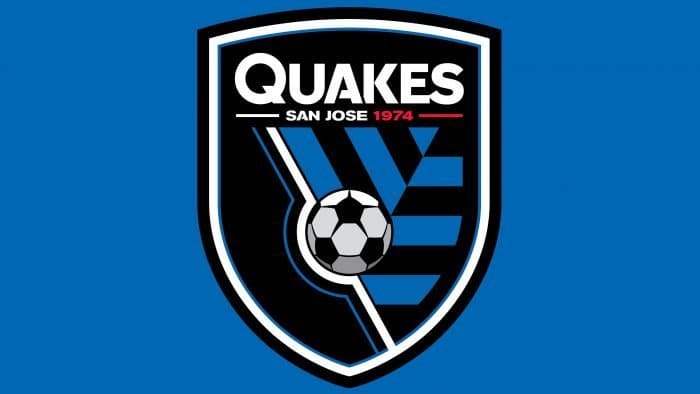Speed, energy, and rapid flight are the key characteristics embodied by the San Jose Earthquakes logo. They perfectly fit the concept of soccer, where quick reaction is necessary for victory. Additionally, the emblem symbolizes precision and accuracy – two extremely important sports qualities.
San Jose Earthquakes: Brand overview
| Founded: | June 15, 1994 |
| Headquarters: | San Jose, California, U.S. |
| Website: | sjearthquakes.com |
San Jose Earthquakes is a member of the Western Conference soccer league and the first professional soccer club in San Jose. Its roots go back to 1974 when the North American Soccer League signed a franchise agreement with the Silicon Valley capital. At that time, it was a little-known city.
The franchise could have gone to San Francisco, but it was purchased by businessman Milan Mandaric, a Yugoslavian immigrant and managing director of the Lika corporation. League Commissioner Phil Woosnam and President Lamar Hunt agreed to the deal on one condition: the new NASL team from the Bay Area had to carry the San Francisco name. They believed San Jose was not prestigious enough to mention.
The local newspaper San Jose Mercury News funded bids for the name. Readers submitted their suggestions, and General Manager Dick Berg approved the name Earthquake. This name evoked public criticism as the city was near the seismically active San Andreas Fault.
On January 16, 1974, Mandaric announced the creation of the “San Jose Earthquakes” soccer club. However, NASL leadership refused to accept it into the league and insisted on replacing “San Jose” with “San Francisco.” The issue was resolved on February 8, 1974. The team’s managers brought compelling arguments and got permission to represent “San Jose.”
In 1983, the club was renamed “Golden Bay Earthquakes”. After playing several matches in the Major Indoor Soccer League and NASL, the team regained its former name. This happened on October 27, 1984, after the main league dissolved. A year later, the franchise joined the Western Soccer Alliance, but in 1988, WSA disbanded, and the team temporarily left the sport.
The team was revived on June 15, 1994, under the name “San Jose Clash” (by Nike’s decision) and joined MLS. Its owner became the Anschutz Entertainment Group. In 2000, “Clash” was replaced with “Earthquakes”. In 2005, AEG announced the relocation to Houston due to the inability to reconstruct the stadium. Players and coaches moved to Texas and founded “Houston Dynamo.” The name, logos, colors, and history of the original club remained in San Jose.
Lewis N. Wolff, an investor in “Oakland Athletics,” continued this legacy. In 2007, he obtained IPR for the franchise and renewed MLS membership. Lewis also owned the Earthquakes Soccer, LLC.
Meaning and History
The original 1995 San Jose logo featured a stylish black-red scorpion with “Clash” in white. In 2000, it was replaced with a triangular shield. Before this, when the team was an NASL member, the word “Earthquakes” occupied most of the “San Jose Earthquakes” logo. A diagonal line from the capital “Q” down symbolized a crack splitting the ball into two.
What is San Jose Earthquakes?
San Jose Earthquakes is a professional soccer team from San Jose, California. Founded in 1994, the team began playing in MLS in 2016 as an expansion franchise. Its main rival is the “Los Angeles Galaxy,” and their confrontation is known as the “California Clasico.” The club is part of the Western Conference and one of the foundational participants of Major League Soccer. Its home stadium is “PayPal Park”.
1996 – 1999
Before becoming “San Jose Earthquakes”, the team was called “San Jose Clash”. This nickname was coined by Nike, which participated in branding. The original club logo depicted a pink scorpion with a yellow outline and a broad black frame. The curved tail was directed upwards, and between the claws was the original inscription “Clash Jose Clash.” The first word stood separately and resembled a bright neon sign. Against it, the city’s name almost disappeared: compared to “CLASH,” it was small and inconspicuous.
2000 – 2005
After rebranding, “San Jose Clash” was renamed “San Jose Earthquakes,” and its logo was updated. It featured an inverted triangular shield with truncated top corners. It was dominated by the official color palette: black-blue, complemented by white-silver.
In the lower part, a soccer ball was drawn with light bursts on the hexagonal faces. From it emanated curved rays symbolizing the rising sun. The logo had a dark background, and other elements were light. The top of the shield featured the words “San Jose” and the bottom – “Earthquakes.”
2005 – 2007
In the new version of the “San Jose Earthquakes” logo, only the color palette was updated. The pale blue shade was darkened, and the rich black was diluted. Other details remained the same. The three-sided shield represented the largest Bay Area cities: Oakland, San Francisco, and San Jose.
The ball on the logo symbolizes the sun, which is used in the emblems of cities. All words were printed in an artistic font: the letters had short, sharp serifs and symmetrical, uneven edges. An arched line was drawn through the word “Earthquakes,” symbolizing a seismic wave.
2008 – 2013
In 2008, the team got a new logo. It was similar to the first two but with minor changes in details. The background was made bright blue, and speckles of the same color appeared on the ball. Decorative protrusions of the shield were changed. The words “San Jose” were supplemented with smooth bends.
Developers experimented with the external lines of the San Jose Earthquakes logo and made them black and white. The broad contour around the word “Earthquakes” and the line symbolizing the seismogram were removed. The team’s name was made white to contrast with the foreground.
2014 – today
In 2014, the club underwent a rebranding, prepared for two years. A Portland-based art design studio added some elements from the past to the “San Jose Earthquakes” logo: the number “1974” (the year the NASL franchise was founded) and red color (as in the first logo). The logo was presented on January 30 as part of the celebration of the 40th anniversary of “San Jose Earthquakes.”
Most of the logo is a triangular shield with black and white edging. In the center, a ball symbolizing an orbit is drawn. On the top right, there are six blue geometric shapes. According to the designers’ concept, they should symbolize shifted tectonic plates.
San Jose Earthquakes: Interesting Facts
Real Salt Lake (RSL) is a soccer team in Utah that’s part of Major League Soccer (MLS).
- Starting Out: RSL began playing in MLS in 2005. They wanted to bring great soccer to Utah and chose a name that showed they wanted to be as famous as the soccer club Real Madrid.
- Their Home: They play at Rio Tinto Stadium, nicknamed “RioT,” since 2008. This place is awesome because it has beautiful views of the Wasatch Mountains.
- Big Win: In 2009, only four years after starting, RSL won its first MLS Cup. They beat the Los Angeles Galaxy in an exciting game that ended in a penalty shootout.
- Going International: In 2011, RSL almost won the CONCACAF Champions League, which was a big deal because they were the first MLS team in a long time to get that far.
- Rivalry: RSL and the Colorado Rapids have a huge rivalry called the Rocky Mountain Cup. Their games are always intense.
- Growing Talent: RSL is good at helping young players become stars. They even have a school for their youth team.
- Famous Players: Players like Kyle Beckerman, Nick Rimando, Javier Morales, and Álvaro Saborío have been important to the team.
- Helping Out: RSL also does a lot to help their community through the RSL Foundation, such as health programs, soccer for kids, and scholarships.
- New Leaders: In 2021, David Blitzer and Ryan Smith took over the team, and they’re all about making the team better and helping the community.
- Traditions: Fans sing the “Believe” anthem before every game. It brings everyone together and gets the team pumped up.
RSL isn’t just about winning games. They care a lot about their fans, helping kids get into soccer and making their community better.
Font and Colors
Designers played with the nickname Earthquakes in various ways, achieving different degrees of success. For example, from 2000 to 2007, emblems depicted a seismogram wave – a chart of the earth’s crust oscillations. The zigzag line crossed the word “EARTHQUAKES,” placed horizontally across the triangular shield.
In the modern logo, the essence of the nickname is reflected more abstractly. Artists decided to depict shifted tectonic plates as alternating geometric shapes of black and blue colors. How successfully this was achieved is hard to judge, as it does not evoke associations with earthquakes.
The emblem is complemented by the phrase “QUAKES SAN JOSE.” The first word is the largest: it’s located at the top of the shield and is immediately noticeable. The city’s name is slightly below and written in small letters. For all inscriptions, a sans-serif font was used. It looks unusual due to interrupted horizontal lines inside the letter “A.”
White words are complemented by the red number “1974”. Designers specifically highlighted the year of the club’s creation to connect the logo with its historical past. The primary color of the shield is black. Against its background, blue elements are clearly visible: the triangle, quadrilaterals, and a thin stripe wrapping the soccer ball on the left side. By the way, the ball itself is black and white, with a slight addition of gray.
San Jose Earthquakes color codes
| Alizarin Crimson | Hex color: | #e31837 |
|---|---|---|
| RGB: | 227 24 55 | |
| CMYK: | 0 89 76 11 | |
| Pantone: | PMS 185 C |
| Medium Persian Blue | Hex color: | #0067b1 |
|---|---|---|
| RGB: | 0 103 177 | |
| CMYK: | 100 42 0 31 | |
| Pantone: | PMS 285 C |
| Black | Hex color: | #000000 |
|---|---|---|
| RGB: | 0 0 0 | |
| CMYK: | 0 0 0 100 | |
| Pantone: | PMS Process Black C |











